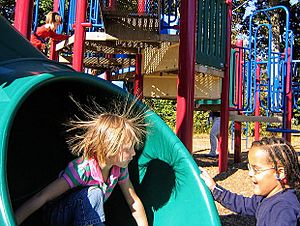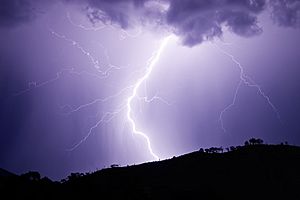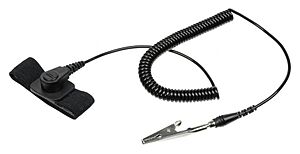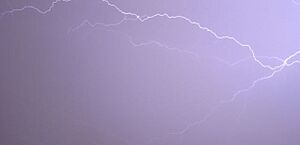Static electricity facts for kids
Static electricity is when an electric charge builds up on the surface of an object. This charge stays put until it can move somewhere else, like into the ground or to another object. You might have felt it as a small shock or seen a tiny spark. This happens when the extra charge suddenly moves away.
You often notice static electricity when you rub two different things together, like rubbing a balloon on your hair. The charge builds up because one of the objects doesn't let electricity flow easily.
Contents
What is Static Electricity?
Static electricity is all about tiny particles called electrons. Everything around us is made of atoms, and atoms have electrons. Sometimes, when two objects touch or rub together, electrons can jump from one object to the other.
- If an object gains extra electrons, it becomes negatively charged.
- If an object loses electrons, it becomes positively charged.
These charges usually stay on the surface of the object. When enough charge builds up, it tries to find a way to balance out, which can cause a spark or a shock.
A Quick Look Back in Time
People have known about static electricity for a very long time!
- Around 600 BC, a Greek thinker named Thales noticed that if he rubbed amber, it could pick up light things like feathers. He didn't know why, but it was an early discovery of static electricity.
- Much later, in the 1600s, Otto von Guericke built the first machine that could create static electricity by rubbing.
- In the 1700s, Benjamin Franklin famously connected static electricity to lightning during storms. He showed that lightning was a huge static discharge.
- In 1832, Michael Faraday proved that static electricity, electricity from magnets, and electricity from batteries were all the same kind of energy. This was a big step in understanding electricity!
How Does Charge Build Up?
There are a few ways that static charges can build up on objects:
Rubbing Things Together
This is the most common way to create static electricity. When you rub two different materials, like your shoes on a carpet or a balloon on your hair, electrons can move from one material to the other.
- For example, when you walk across a carpet and then touch a metal doorknob, you might feel a small shock. This is because your body gained or lost electrons from the carpet, and they jumped to the doorknob to balance out.
Pressure on Certain Materials
Some special materials, like certain crystals, can create a separation of charge when you put strong pressure on them. This is called the piezoelectric effect.
Heating Certain Materials
Heating some materials can give their electrons enough energy to break free from their atoms. When atoms lose electrons, they become positively charged, leading to a buildup of static charge.
When a Charged Object is Nearby
If a charged object comes close to a neutral (uncharged) object, it can make the charges in the neutral object separate.
- Opposite charges attract each other (positive pulls negative).
- Same charges push each other away (positive pushes positive, negative pushes negative).
This means the side of the neutral object closest to the charged object will get an opposite charge. This effect gets weaker very quickly as the objects move apart.
Getting Rid of Static Charge
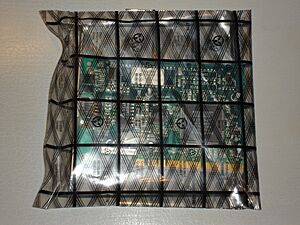
Sometimes, too much static electricity can be a problem. Here's how people deal with it:
- Adding Moisture: If the air is dry, static electricity builds up more easily. Opening a window or using a humidifier adds moisture to the air. Water helps electricity flow, so the static charge can escape more easily.
- Antistatic Sprays and Agents: You can use special sprays or liquids called antistatic agents. These create a thin layer on a surface that helps electricity move, so charges don't build up. Fabric softeners used in laundry are an example, stopping clothes from sticking together.
- Protecting Electronics: Many electronic parts are very sensitive to static electricity. A small static shock can damage them.
- They are often stored in special antistatic bags that conduct electricity.
- People who work with these parts often wear an antistatic wrist strap. This strap connects them to the ground, so any static charge on their body safely flows away.
- Special Shoes: In places like factories or hospitals, workers might wear safety boots with special soles that conduct electricity. This stops static charges from building up on their bodies as they walk. These are different from insulating shoes, which protect against electric shocks.
Static Discharge: The Spark!
A "static discharge" is when the extra charge on an object suddenly moves away.
- If an object has too many electrons (negative charge), it will lose them to its surroundings.
- If an object has too few electrons (positive charge), it will gain them from its surroundings.
The feeling of a static shock happens when this balancing current flows through your body. Because your body has a lot of water, the charge usually isn't enough to be dangerous.
Lightning is a very powerful example of static discharge. Clouds can build up a huge amount of electric charge by rubbing against each other. When the charge gets too big, it jumps to the ground or another cloud, creating a giant spark we call lightning!
Even though static electricity usually isn't harmful to people, a very large static charge can sometimes damage sensitive equipment in labs or factories.
Images for kids
-
Ozone cracking in natural rubber tubing
See also
 In Spanish: Electricidad estática para niños
In Spanish: Electricidad estática para niños


